Last updated on August 13th, 2024 at 04:16 pm

We set off with friends David and Cecile (and Hamish the dog) to visit Swaledale’s corpse trail. It is one of their favourite walks and the views are terrific. You may know of Yorkshire’s Swaledale, but I suppose I had better explain what a corpse trail is: so here goes. Once upon a very long ago time, remote and scattered communities often had no convenient consecrated burial ground. A corpse way, corpse road, coffin lane, lych way – they have a variety of names – is a very old track along which they carried their dead to a final resting place, often some distance away. These pathways can still be found, although, unrecorded or forgotten, they are not always obvious. However, some are well known. I was aware of at least one in Dartmoor, there are a couple in the Lake District, the Highlands – and the one in Swaledale used to run from Keld to Grinton, a distance of some 12 miles, before St Mary’s church was built in Muker in 1580.
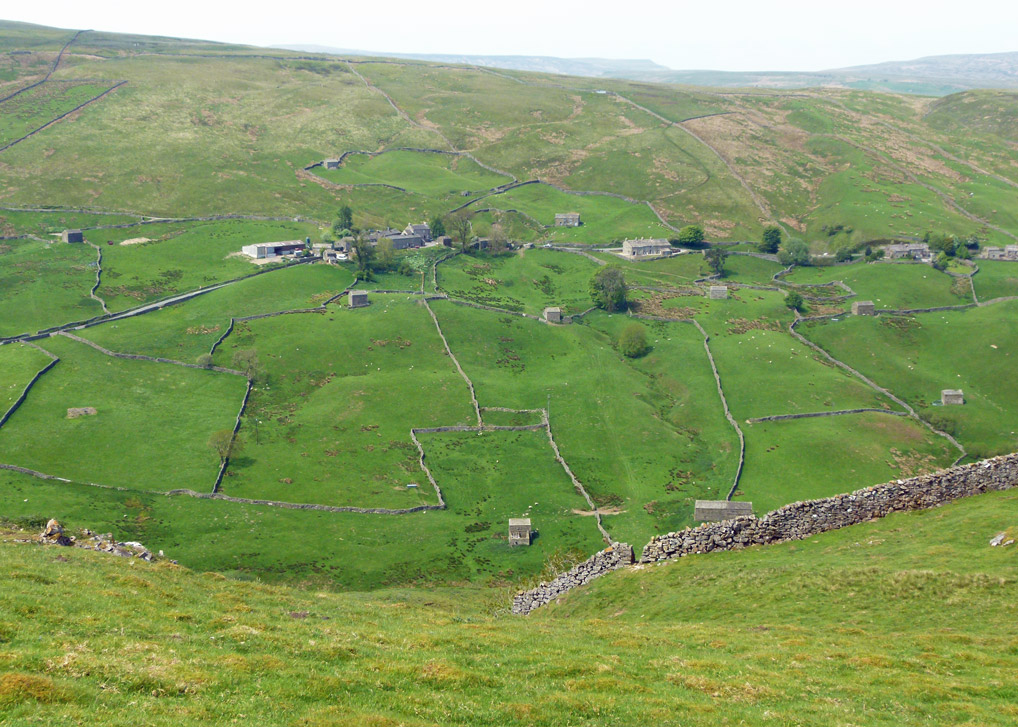
Of course, there are stories and superstitions associated with corpse roads. The routes can be indirect and isolated, for very good reasons. People were naturally wary of transporting bodies along tracks the deceased knew in life, lest their freed spirits find their way back home, to linger amongst familiar places, and people. A corpse way might also twist and turn. This was intentional, to confuse ghosts that may prefer to travel in straight lines. It is perfectly understandable to feel something as you tread the last journey taken by the departed, all those years ago. A profound sense of sadness and melancholy, perhaps? Anger? Regret? Did you hear a whisper – or was it just the breeze rustling through the grass? A child’s cry – or the evocative call of a curlew? You might even encounter wraiths – especially on bleak days when the light is low. But be mistrustful of corpse lights bobbing ahead or around as you walk. They may be malevolent will o’ the wisps that lead unsuspecting travellers to danger; or they may merely be lost souls trying – so very hard – to find their way.


One feature of corpse roads is the coffin stone, a flat(ish) slab where tired cadaver-carriers might rest their burden along the way. Actually, I can’t help wondering how many families would have been able to afford the luxury of a coffin. It would have been a tough gig in any case, especially in bad weather. And the weather in the Yorkshire Dales can be as bad as bad can be in any part of England. There was no coffin stone along the section of corpse road we took, but there is one farther east along the trail, at Ivelet Bridge. Yet another oddity added to the list of things I want to see before I die.

Anyway, that’s a bit about corpse trails. Swaledale is always worth revisiting and the journey there, by way of Buttertubs, is spectacular, if sometimes treacherous in winter. It was a luxury not to be driving for a change and have a chance to take in the sweeping scenery. Yorkshire in late May 2023 was looking its very best. The May blossom was particularly prolific. Did you know that in medieval times the smell of hawthorn reminded people of the plague, because it is so foul? You do now. Go and sniff some immediately – I’m just going to. Apparently, the flowers produce the chemical trimethylamine, which is one the first chemicals released in decaying animal tissue. Inexplicably, some people consider it unlucky to bring hawthorn into the house.

The artery of Swaledale is the River Swale, one of the fastest rising flood rivers in England, with its source in the fells north of the village of Keld. It then flows generally east, its waters eventually joining the Humber estuary via the rivers Ure and Ouse. The valley of the Swale, Swaledale, is a treat – a patchwork of irregular fields stitched with drystone walls and speckled with stone barns preserved in various stages of decay. It is all so very Yorkshire. Now then. A Bit About Britain has walked there before, and you can read a bit about that, as well as the history, at Swaledale ‘twixt Muker and Keld. One sight I had not experienced, but was looking forward to, was the traditional hay meadows in full bloom with wild flowers. From the 1940s to the 1980s, Britain lost some 97% of its hay meadows, with a hideous impact on biodiversity. I gather that trend has not been reversed.



David and Cecile (and Hamish) took us from Muker up Kisdon Fell, a hill isolated by glaciation from the surrounding high ground, bounded by Swaledale to its east and the valley of the beck, or stream, that trickles through it on the west – Skeb Skeugh. Most of the names in these parts have Norse origins. The route took us along the corpse way, albeit against the traffic that would have come in the opposite direction, from Keld. I heard wheezing – from me, not some ghostly funeral party. It was worth it for the views, sublime in the warmth and light of a late spring day; but, oh my word, it would be bleak in winter.

We came upon an unusual piece of dressed stone that had been set into one of the dry walls. It was inscribed:
“Neil W. Jones aged 40 died here 29 March 2005
A beautiful place
A wonderful man”.
This touching memorial immortalises a day when Neil, on holiday and out for a walk and picnic with his wife Laura, had a heart attack. You can read a bit more about it here.

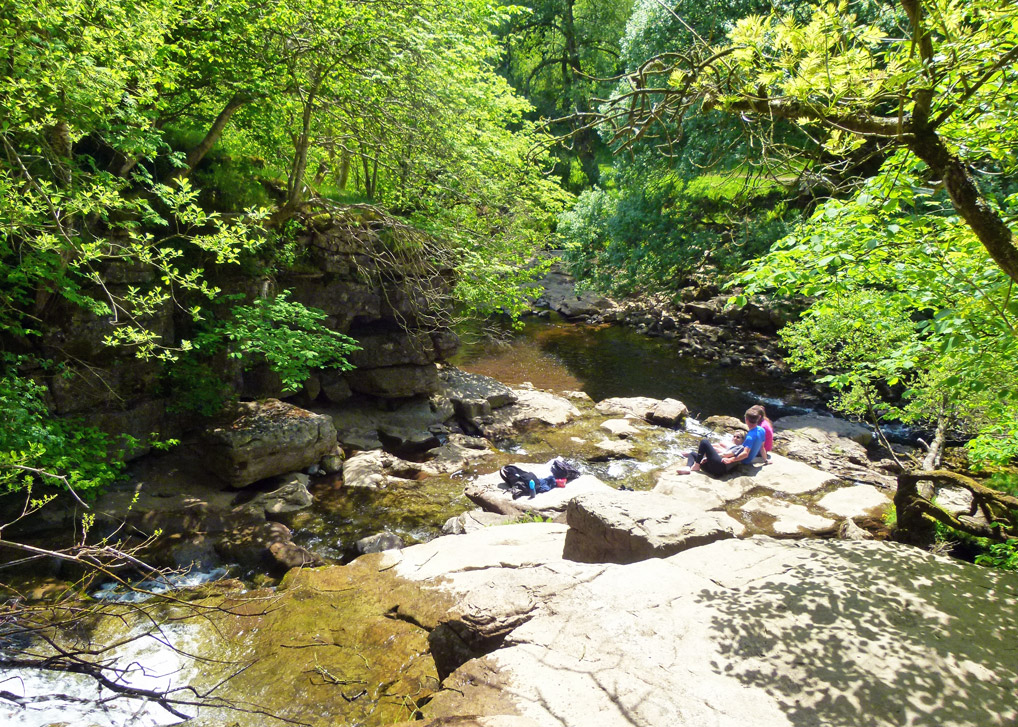

Hamish was having a lovely time, tail wagging furiously, happily inspecting every rabbit hole. Skirting Keld, David semi-confidently led us off piste over bouncing, tussock-spattered, pathless fields, finally crossing the Swale by Kisdon Force. Here, we settled down on the stones to enjoy our own picnic. (Yes, it was very nice, thank you.) I resisted the temptation to advise the large shirtless guy posing by the falls to follow my example and cover his tummy, but he seemed happy. Perhaps he is contemplating a career on Instagram.
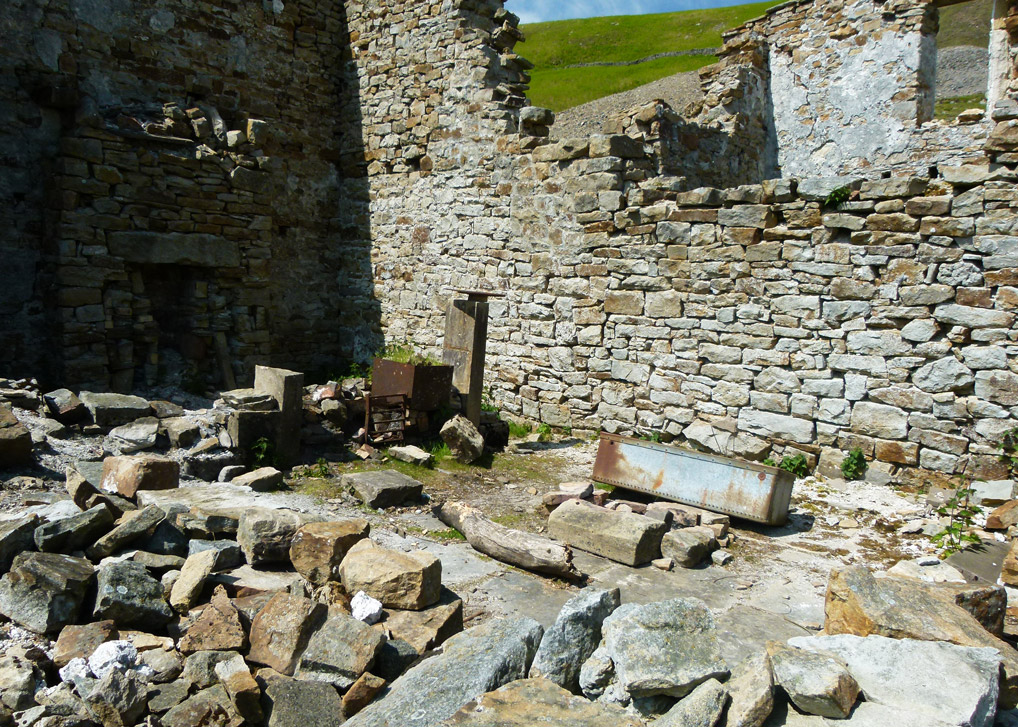

Afterwards, we set off along the dale back to Muker, taking a necessary detour to visit the evocative abandoned ruins of Crackpot Hall – previously mentioned here.
Muker’s meadows are spectacular, a privilege to see. They simply ooze happy summers and you want to bury your head in them. However, there were fewer insects – including bees – than I expected. Is it already too late for our wildlife? Presumably, if it were economically advantageous to restore traditional meadows, it would happen in a heartbeat. I do wonder, as I get older, not whether mankind will destroy itself, but how: war, famine, pestilence, pollution, AI? Meanwhile, the headlines feature not even joyous news stories, but the latest celebrity crisis, or political malfeasance. We are so lucky to be able to enjoy places like Swaledale, in peace and freedom, while we can.
The walk can be found on the Yorkshire Dales website and I can recommend an ice cream in Muker afterwards.
The writer Icy Sedgwick has something to say about corpse roads. You’ll find her on Twitter, too.
Country File mentions a bit about other coffin roads in Britain.


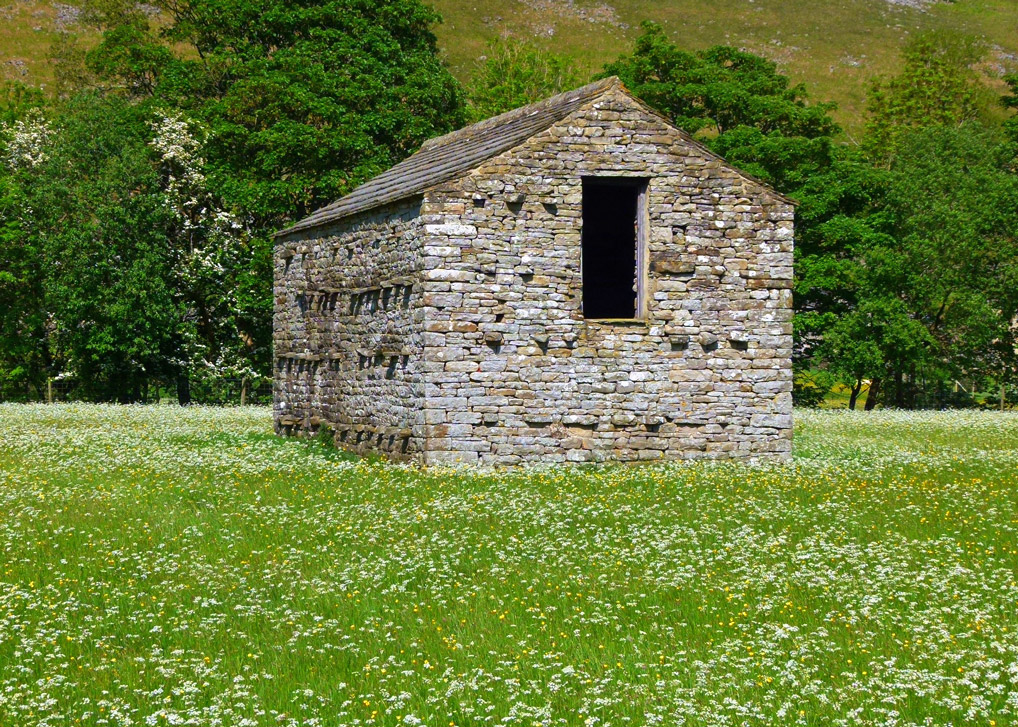
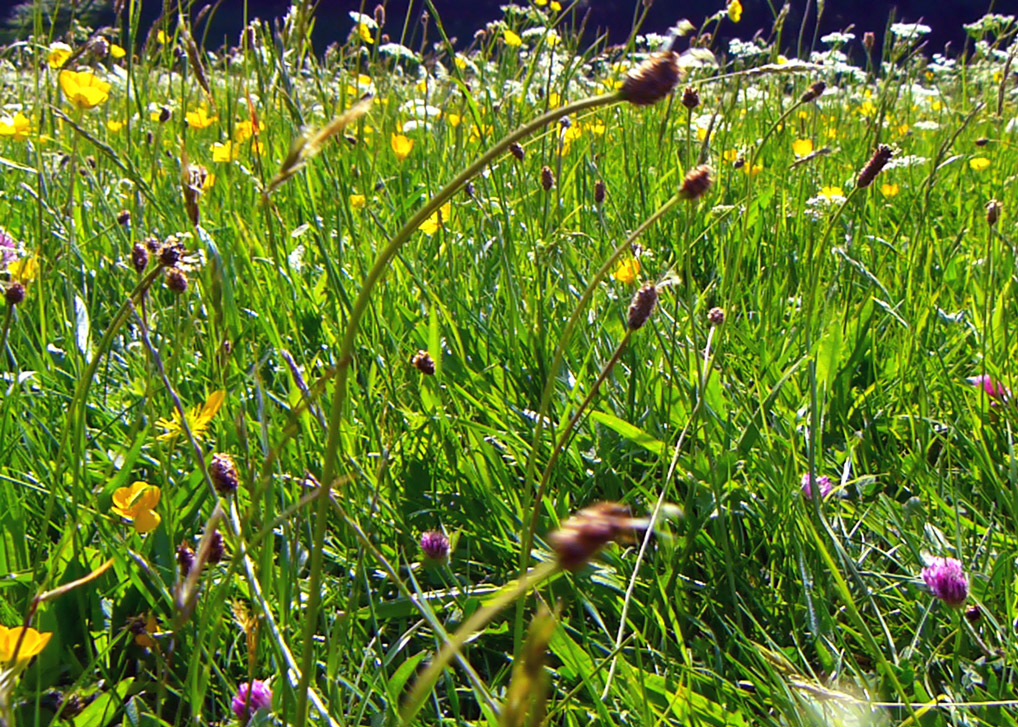



Hi Mike – what a great post … fascinating to read and so pleased you both went along with your friends and Hamish, their dog. Incredible photos – wonderful … and yes the knowledge about Corpse Ways … I’d not heard about – but logical … cheers Hilary
Thanks, Hilary. It was a great walk – and fun to write about. I really loved those meadows.
Fascinating information about the Corpse Road.
Hi CP. Yes, tickles the imagination no end, doesn’t it!
This is absolutely beautiful. I reminds me of “All Creatures Great and Small.” And thanks for the history of the corpse trails. Very interesting.
Well, Jeanie, not that far from “All Creatures Great and Small” country! The Dales are very special.
I had never heard of a corpse road so this was interesting. I enjoyed the pictures of the lovely countryside and appreciated the links to further info. Thanks for sharing.
Thanks, Marge. It’s a genuine pleasure – and great when people say nice things 🙂
I didn’t know about a corpse road. That you! Your tidbits and humor are wonderful, and I love the photos. Yes, thank goodness there are places like Swaledale in lieu of the everyday press. Best to you, Mike.
Thanks, Jennie. Yes, I’m intrigued by the whole corpse road thing – I need to find another one. Dartmoor would be good – I love Dartmoor.
You’re welcome, Mike. On to Dartmoor!
How delightful. Even the sprites and wights and skelpies that must frequent those parts. I was touched by the story of Laura and Paul. Though I must admit I was wondering in the back of my conspiratorial bonce whether they didn’t go at it somewhat sooner than the story on t’ website claims. I guess we’ll just have to take their word for it. Mind you, you might want to be careful when out walking in remote places with ‘t missus. Wouldn’t want to find out something was slipped into your packed lunch ham and avocado sandwich that suddenly has you clutching at your chest in pain. Not suggesting anything here mind . . .
Thank God – I’m not a huge fan of avocado…
Thanks, Andy!
All that lovely velvet green makes you want to run down the hills.
I must admit, I did feel my Julie Andrews impersonation coming on at one point.
How serene. A lovely walk that. Thankyou
Thank YOU – glad you enjoyed it!
That’s wonderful scenery….right away from the vile world of the media, the politics and the sheer rottenness of contemporary life. Glad you saw the meadows in flower.
My grandmother would not have any white flower in the house…said it was the colour of mourning.
You’re right (that’s twice) – the world does look somewhat vile at the moment. So much tragedy, strife and stupidity in the news. Interesting about the white flowers – when did black become the colour of mournng?
Thanks for the interesting info!
Thanks for finding it interesting!
Looks like a beautiful place to take a walk and reconnect 🙂
It is, Meg. Not sure about reconnecting on that corpse road, though 🙂
Thank you so much for these lovely photos. They bring back memories to me, of my two trips to the UK and the Yorkshire moors and dales. Been there…loved every minute!
That’s great, Cynthia – delighted to be of service! Come back soon.
Since hawthorn smells so foul, why would anyone want to take it into their home? Personally, I prefer roses.
The closest I’ve been to Swaledale is Richmond, where I crossed the river several times as I attempted to find my B&B.
I’m with you on the roses. Richmond is lovely – but obviously has elusive accommodation. Next time you’re there, head up river a bit…
A really good description of a walk and the history it evokes. I had not known about corpse ways, and enjoyed your musings thereon.
Thanks, Derrick. I guess they only had corpse roads in remote areas.
My kind of walk, with everything I love: meadows in bloom, abandoned barns and places, a route steeped in history, a waterfall, a picnic, a pleasant village, drystone walls… Just wonderful!
Maybe you have seen some of my posts about my recent May break. I could not get enough of those meadows covered in wildflowers, and only on our very last day did we spot one of the farmers start the cutting.
I just dropped in on your blog, Meike, and found your lovely photos. Sorry I don’t visit more often!
Marvelous views!
Yes, they’re wonderful. Thanks, William.
A wonderful post Mike, much enjoyed. I loved driving over Buttertubs but don’t think I would relish being a passenger!
Thanks, Peter! Leather is better than fabric when the weather’s bad.
Yes, so very typically Yorkshire, even down to the odd sounding place names. There are few things as exhilarating and liberating as a hike out in the quiet countryside where you can almost forget what the country/world/human race is turning/has turned into.
Very true!
Swaledale does look lovely 🙂
All the best Jan
It is, Jan. Thanks for dropping by – hope all is tickety-boo.
What an interesting place, I liked the photos, I travel the world via my computer and posts like yours, so I thank you
That’s a good way of seeing different places, Joanne. The Internet isn’t all bad.
Wow, there is so much beauty here! I love the names too like Swaledale. I’ve never heard of a corpse road, very spooky. The landscapes are incredibly beautiful, you are very blessed to be there, Mike! Thanks for sharing this. ❤️
Thanks, John. Yes, the names are great, aren’t they!? And it is a lovely landscape – when the weather’s kind; dramatic when it isn’t.
Indeed!
Thank you for answering all my uncertainties about the corpse walk – and for your wonderful company! David
It could certainly get the imagination going! Thank you for yours – and the intro!
Gorgeous scenery.
Isn’t it?! We’re very lucky – lots to places to choose from!
I love that part of England!! (except for Buttertubs Pass) and your recounting of your time spent there. Your last paragraph, so sad and yes, my thoughts also.
They have fenced the Buttertubs in now, Judy – presumably so they can’t escape. I accept that the road can be interesting when the weather is less than clement.
I enjoyed this post so much, and such glorious photos. Love, love love! Thanks for walking and writing!
Thank you so much. I’m a bit behind responding to comments – sorry!
Swaledale is a place I don’t know. It looks beautiful. It’s something I must remedy. And the coffin walks sound interesting, if a little gruesome.
When I was a child, hawthorn was said to be unlucky to bring into the house. No reason ever given. As to smell–well,I think elder smells worse.
Oh, I can recommend a visit to Swaledale. Oddly, I quite like the smell of elder – and I do have fond, but slightly fuzzy, memories of mum’s homemade elderberry wine.
Oh, yes! Elderberry wine! Wonderful. I made it myself many years ago. And elderberry jam. My son makes a great elderflower cordial, too.